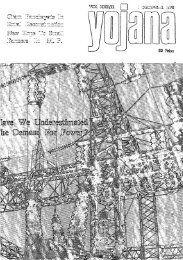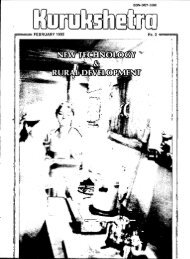Banking - Yojana
Banking - Yojana
Banking - Yojana
- TAGS
- banking
- yojana
- yojana.gov.in
You also want an ePaper? Increase the reach of your titles
YUMPU automatically turns print PDFs into web optimized ePapers that Google loves.
Generated by PDFKit.NET Evaluation<br />
•<br />
earlierwritersurged the importance<br />
of wealth in the consumption<br />
fu.nction. They viewed that saving<br />
may be motivated by the desire to<br />
market bequests of other transfer of<br />
wealthto the next generation, aswell<br />
as by the need to even out<br />
consumption over the saver's<br />
lifetimes.The adequacy of wealth to<br />
meet a bequest target will then be<br />
one of the determinants of current<br />
savingand consumption.<br />
A.C. Pigou (1947) emphasised<br />
the wealtheffect in the course of an<br />
abstract theoretical attack on the<br />
wholestructure ofKeynes's'General<br />
Theory'. Pigoupointed out that the<br />
real valueof private wealth could be<br />
indefinitely increased by price<br />
deflation. The reason is that<br />
deflation would increase the<br />
purchasing power of money. As the<br />
owners of assets become saturated<br />
with real wealth, their propensity to<br />
consume is bound to increase. Via<br />
what has come to know be as "the<br />
Pigou effect", the absolute price<br />
level-because of its effect on the<br />
real value of private wealth-has a<br />
bearing on the propensity to<br />
consume.<br />
Walter Dolde and James Tobin<br />
(1971) in a Wealth Model of<br />
Consumption illustrated that all<br />
wealth, human and 'non-human,<br />
future' yields of labour as well as<br />
future yields of bonds and stocks is<br />
available at its capitalised value for<br />
consumption now or any future<br />
.ime. Wealth is completely fungible<br />
between periods. At the level of<br />
individual households in budget<br />
surveys, past saving of course<br />
supports the dissavingrecorded for<br />
the lower brackets. As pointed out<br />
by Tobin (1951), differences in the<br />
wealth available to households at a<br />
given real income can help to<br />
explain the differences observed in<br />
differen t surv'eys in their<br />
propensities to save or to dissave.<br />
This explanation is not inconsistent<br />
with those by which Duesenberry,<br />
Friedman, and Modiglian in the<br />
same phenomenon.<br />
The qRatio<br />
Investment is a theoretically<br />
complex topic. Tobin and Brainard<br />
(1977) in a pioneering effort<br />
formulated a financial approach to<br />
investment. Tobin devised a wayof<br />
relating investment demand to<br />
financial variables, which is<br />
amenable to empirical treatment.<br />
Investment is hypothesised to<br />
depend positively on the q-ratio,<br />
where q = p / a. Valuation Ratio =<br />
rate of return on investment/cost of<br />
capital. Firm's investment is<br />
expected to be higher, the larger is<br />
q.<br />
Tobin's logic is whether the firm<br />
should expand or contract can be<br />
judged by the market value of a<br />
firm's stock relative to the current<br />
cost of its assets.This has led Tobin<br />
to conclude that a firm should<br />
expand (by investing in new plant<br />
and equipment) if its q is greater<br />
than one (q>1).J.M. Keynes in his<br />
"General Theory" (1936) has<br />
pointed out thisconnection between<br />
investmentand market valuerelative<br />
to cost. Tobin has argued that q is<br />
the channel through whichfinancial<br />
market events influence real<br />
economic activity.Events that raise<br />
market valuerelativetoreplacement<br />
cost stimulate physical investment.<br />
The observed value of q is both a<br />
yardstick by which investment<br />
should be judged and also a<br />
barometer for predicting investment<br />
activity.Stockpricesare used in many<br />
macroeconometric models to help<br />
explain investment and to predict<br />
the future course of the economy.<br />
The policy makers and<br />
macroeconometric model builders<br />
use aggregate q data to monitor the<br />
over all course of the economy. An<br />
aggregate q index provides a broad<br />
measure of the incentives for<br />
aggregate income. Tobin's q isvery<br />
helpful in formulating the theory of<br />
investment demand. When the<br />
optimal capital sto'ci






